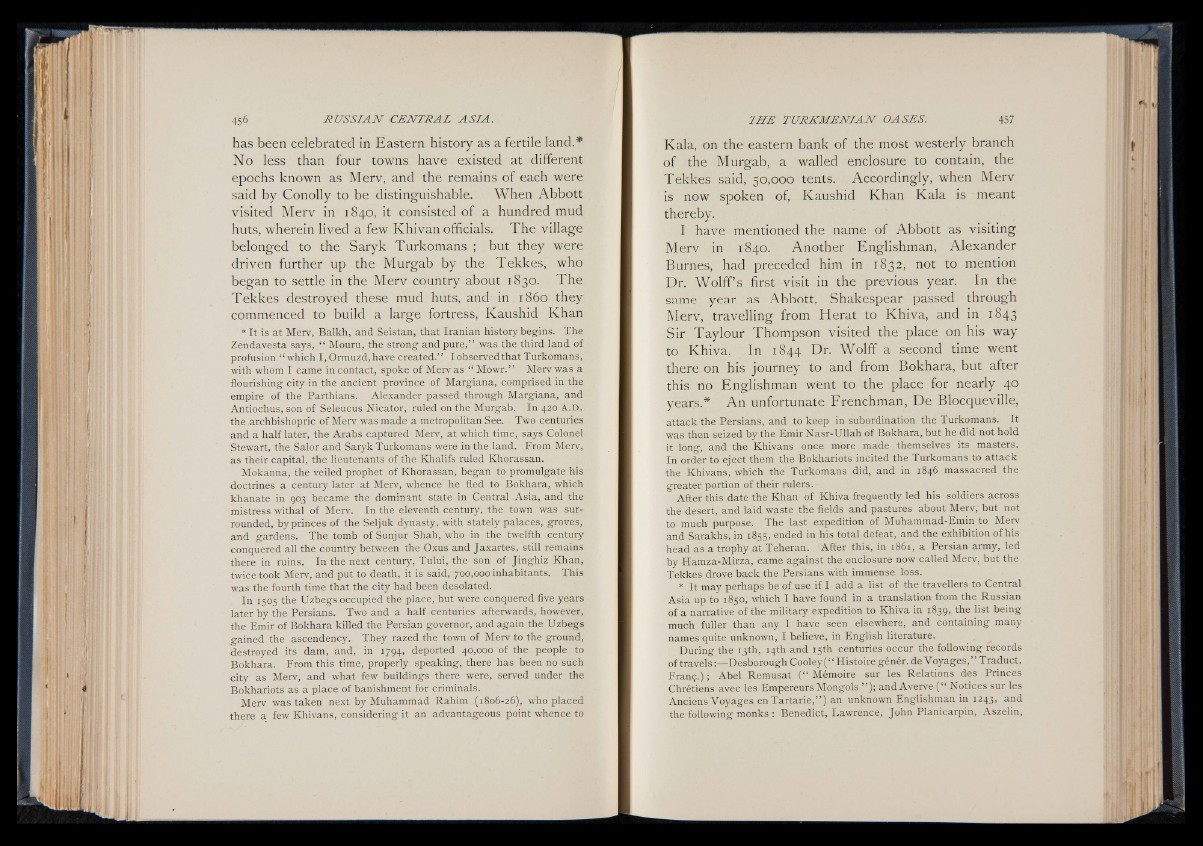
has been celebrated in Eastern history as a fertile land.*
No less than four towns have existed at different
epochs known as Merv, and the remains of each were
said by Conolly to be distinguishable. When Abbott
visited Merv in 1840, it consisted of a hundred mud
huts, wherein lived a few Khivan officials. The village
belonged to the Saryk Turkomans ; but they were
driven further up the Murgab by the Tekkes, who
began to settle in the Merv country about 1830. The
Tekkes destroyed these mud huts, and in i860 they
commenced to build a large fortress, Kaushid Khan
* It is at Merv, Balkh, and Seistan, that Iranian history begins. The
Zendavesta says, “ Mouru, the strong and pure,” was the third land of
profusion “ which I, Ormuzd, have created.” I observed that Turkomans,
with whom I came in contact, spoke of Merv as “ Mowr.” M'erv was a
flourishing city in the ancient province of Margiana, comprised in the
empire of the Parthians. Alexander passed through Margiana, and
Antiochus, son of Seleucus Nicator, ruled on the Murgab. In 420 A .D .
the archbishopric of Merv was made a metropolitan See. Two centuries
and a half later, the Arabs captured Merv, at which time, says Colonel
Stewart, the Salor and Saryk Turkomans were in the land. From Merv,
as their capital, the lieutenants of the Khalifs ruled Khorassan,
Mokanna, the veiled prophet of Khorassan, began to promulgate his
doctrines a century later at Merv, whence he fled to Bokhara, which
khanate in 903 became the dominant state in Central Asia, and the
mistress withal of Merv. In the eleventh century, the town was surrounded,
by princes of the Seljuk dynasty, with stately palaces, groves,
and gardens. The tomb of Sunjur Shah, who in the twelfth century
conquered all the country between the Oxus and Jaxartes, still remains
there in ruins. In the next century, Tului, the son of Jinghiz Khan,
twice took Merv, and put to death, it is said, 700,000 inhabitants. This
was the fourth time that the city had been desolated.
In 1505 the Uzbegs occupied the place, but were conquered five years
later by the Persians. Two and a half centuries afterwards, however,
the Emir of Bokhara killed the Persian governor, and again the Uzbegs
gained the ascendency. They razed the town of Merv to the ground,
destroyed its dam, and, in 1794, deported 40,000 of the people to
Bokhara. From this time, properly speaking, there has been no such
city as Merv, and what few buildings there were, served under the
Bokhariots as a place of banishment for criminals.
Merv was taken next by Muhammad Rahim (1806-26), who placed
there a few Khivans, considering it an advantageous point whence to
Kala, on the eastern bank of the most westerly branch
of the Murgab, a walled enclosure to contain, the
Tekkes said, 50,000 tents. Accordingly, when Merv
is now spoken of, Kaushid Khan Kala is meant
thereby.
I have mentioned the name of Abbott as visiting
Merv in 1840. Another Englishman, Alexander
B urnes, had preceded him in 1832, not to mention
Dr. Wolff’ s first visit in the previous year. In the
same year as Abbott, Shakespear passed through
Merv, travelling from Herat to Khiva, and in 1843
Sir Taylour Thompson visited the place on his way
to Khiva. In 1844 Dr. Wolff a second time went
there on his journey to and from Bokhara, but after
this no Englishman went to the place for nearly 40
years.* An unfortunate Frenchman, De Blocqueville,
attack the Persians, and to keep in subordination the Turkomans. It
was then seized by the Emir Nasr-Ullah of Bokhara, but he did not hold
it long, and the Khivans once more made themselves its masters.
In order to eject them the Bokhariots incited the Turkomans to attack
the Khivans, which the Turkomans did, and in 1846 massacred the
greater portion of their rulers. •
After this date the Khan of Khiva frequently led his soldiers across
the desert, and laid waste the fields and pastures about Merv, but not
to much purpose. The last expedition of Muhammad-Emin to Merv
and Sarakhs, in 1855, ended in his total defeat, and the exhibition of his
head as a trophy at Teheran. Affer this, in 1861, a Persian army, led
by Hamza-Mirza, came against the enclosure now called Merv, but the
Tekkes drove back the Persians with immense loss.
* It may perhaps be of use if I add a list of the travellers to Central
Asia up to 1850, which I have found in a translation from the Russian
of a narrative of the military expedition to Khiva in 1839, the bst being
much fuller than any I have seen elsewhere, and containing many
names quite unknown, I believe, in English literature.
During the 13th, 14th and 15th centuries occur the following records
of travels:—Desborough Cooley (“ Histoire génér. de Voyages, ” Tradu et.
Franç.) ; Abel Remusat (-“ Mémoire sur les Relations des Princes
Chrétiens avec les.Empereurs Mongols ” ); and Averve ( “ Notices sur les
Anciens Voyages en Tartarie,” ) an unknown Englishman in 1243, and
the following monks : Benedict, Lawrence, John Planicarpin, Aszelin,